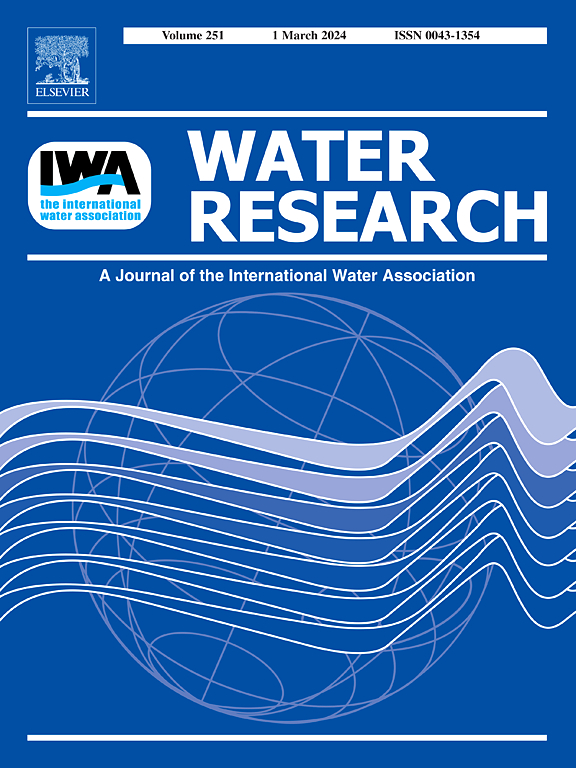Isotopically Tracing the Impact of Water Contaminant “Cocktails” on Nitrogen Pathways in Constructed Treatment Wetlands
IF 11.4
1区 环境科学与生态学
Q1 ENGINEERING, ENVIRONMENTAL
引用次数: 0
Abstract
Constructed wetlands mitigate nitrogen (N) loads in surface runoff, yet implications of common contaminant “cocktail” mixtures to wetland N removal are relatively unexplored. A 15N isotopic tracer was used to assess the impact contaminants from urban (imidacloprid, caffeine, and PFOS) and rural (atrazine, glyphosate, and sulfate) environments have on nitrogen (N) pathways in free-water surface wetlands (FWS) and floating treatment wetlands (FTW). Nitrate-N removal rates ranged from 0.20 to 0.68 d-1 and were dependent on the contaminant mixture and wetland design. Of the enriched 15N, biomass uptake accounted for 36.5 ± 30.7%, 6.3 ± 4.2% was denitrified and lost through air-water exchange, and 55.9 ± 24.4% was assumed to have been denitrified and transmitted through plant tissues or lost due to ebullition (bubbling). The FTWs had increased temporary storage of N while the FWSs had increased permanent removal. In the presence of contaminant mixtures, both designs observed a shift in the NO3-N removal pathway toward increased biomass uptake. Caffeine (59.7 ± 3.6%), PFOS (65.9 ± 8.8%), atrazine (92.0 ± 0.6%), and glyphosate (>89.1%) were effectively removed from the water with limited removal for SO42- (2.3 ± 12.3%). Findings elucidate implications to N fate and maintenance required (e.g., biomass harvesting) in two constructed pulse flow wetlands positioned in urban and rural landscapes while providing a clear understanding of how system design and water quality characteristics impact biogeochemical cycling.

水污染物“鸡尾酒”对人工处理湿地氮途径影响的同位素追踪
人工湿地减轻了地表径流中的氮(N)负荷,但常见污染物“鸡尾酒”混合物对湿地氮去除的影响相对未被探索。采用15N同位素示踪剂评估了城市环境(吡虫啉、咖啡因和全氟辛烷磺酸)和农村环境(阿特拉津、草甘膦和硫酸盐)污染物对自由水面湿地(FWS)和浮动处理湿地(FTW)中氮(N)途径的影响。硝酸盐- n去除率范围为0.20 ~ 0.68 d-1,取决于污染物混合物和湿地设计。在富集的15N中,生物量吸收占36.5±30.7%,6.3±4.2%被反硝化并通过空气-水交换损失,55.9±24.4%被认为是反硝化并通过植物组织传递或因沸腾(冒泡)而损失。FTWs增加了N的临时储存,而FTWs增加了永久清除。在存在污染物混合物的情况下,两种设计都观察到NO3-N去除途径向增加生物量吸收的转变。咖啡因(59.7%±3.6%)、全氟辛烷磺酸(65.9±8.8%)、阿特拉津(92.0±0.6%)和草甘膦(89.1%)被有效去除,SO42-的去除率有限(2.3±12.3%)。研究结果阐明了位于城市和农村景观中的两个人工脉冲流湿地对N的命运和维护所需的影响(例如,生物质收获),同时提供了对系统设计和水质特征如何影响生物地球化学循环的清晰理解。
本文章由计算机程序翻译,如有差异,请以英文原文为准。
求助全文
约1分钟内获得全文
求助全文
来源期刊

Water Research
环境科学-工程:环境
CiteScore
20.80
自引率
9.40%
发文量
1307
审稿时长
38 days
期刊介绍:
Water Research, along with its open access companion journal Water Research X, serves as a platform for publishing original research papers covering various aspects of the science and technology related to the anthropogenic water cycle, water quality, and its management worldwide. The audience targeted by the journal comprises biologists, chemical engineers, chemists, civil engineers, environmental engineers, limnologists, and microbiologists. The scope of the journal include:
•Treatment processes for water and wastewaters (municipal, agricultural, industrial, and on-site treatment), including resource recovery and residuals management;
•Urban hydrology including sewer systems, stormwater management, and green infrastructure;
•Drinking water treatment and distribution;
•Potable and non-potable water reuse;
•Sanitation, public health, and risk assessment;
•Anaerobic digestion, solid and hazardous waste management, including source characterization and the effects and control of leachates and gaseous emissions;
•Contaminants (chemical, microbial, anthropogenic particles such as nanoparticles or microplastics) and related water quality sensing, monitoring, fate, and assessment;
•Anthropogenic impacts on inland, tidal, coastal and urban waters, focusing on surface and ground waters, and point and non-point sources of pollution;
•Environmental restoration, linked to surface water, groundwater and groundwater remediation;
•Analysis of the interfaces between sediments and water, and between water and atmosphere, focusing specifically on anthropogenic impacts;
•Mathematical modelling, systems analysis, machine learning, and beneficial use of big data related to the anthropogenic water cycle;
•Socio-economic, policy, and regulations studies.
 求助内容:
求助内容: 应助结果提醒方式:
应助结果提醒方式:


